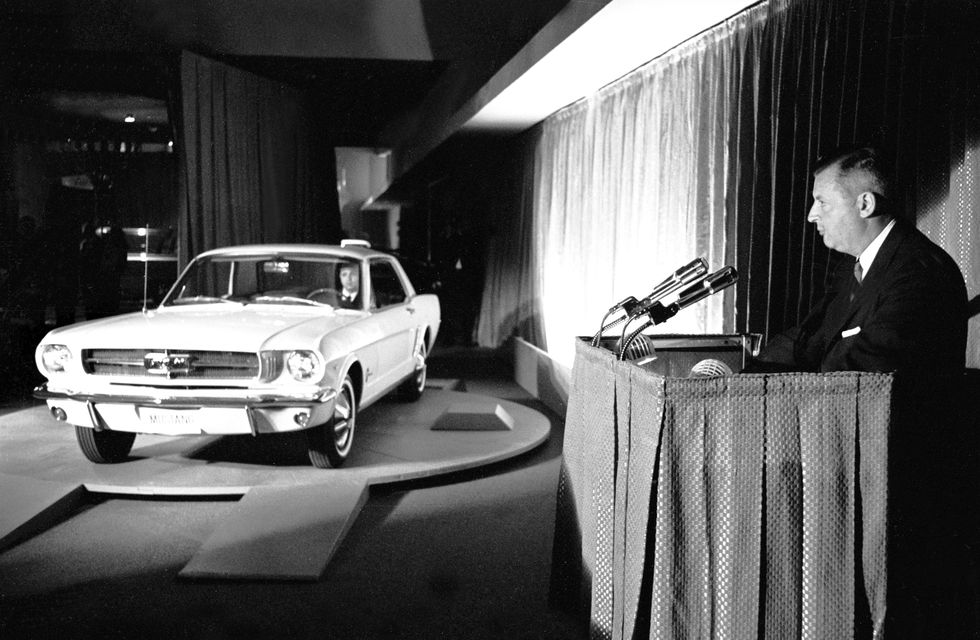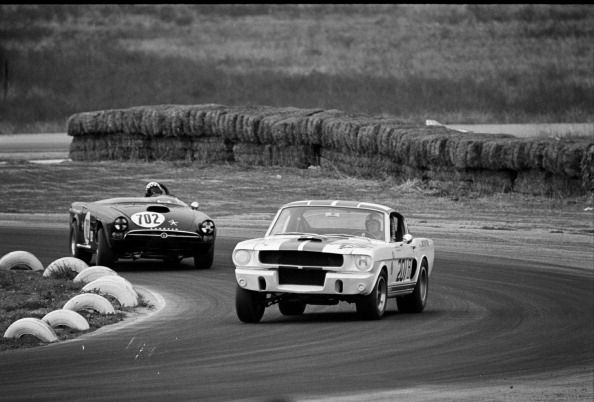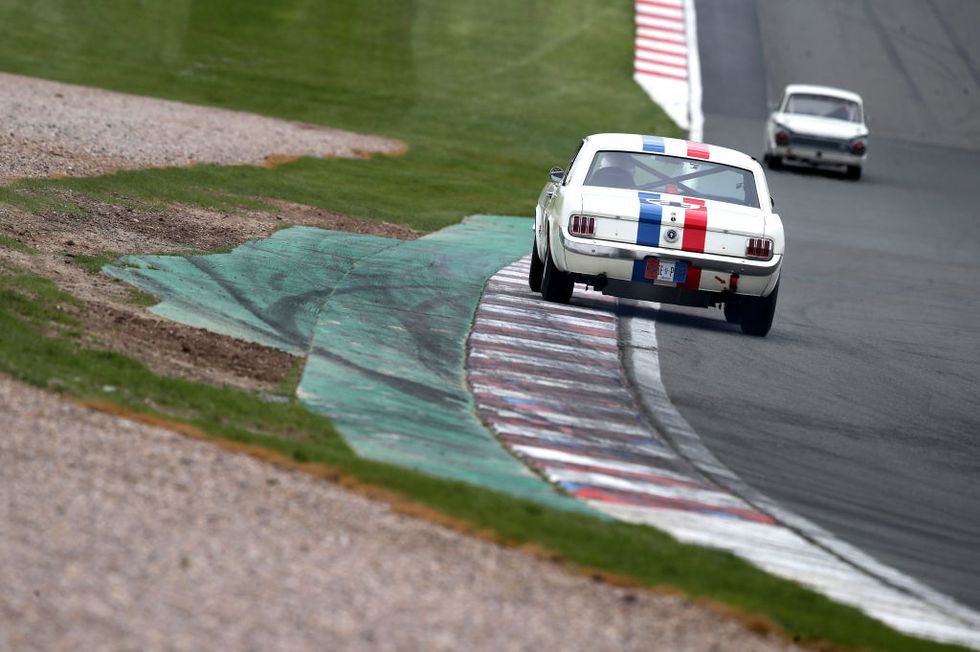It’s been 60 years since the world was first introduced to the Ford Mustang at the 1964 New York World’s Fair. In the time since, the pony car has come to dominate the segment it birthed, selling well over 10 million copies in more than 100 countries across the globe. It’s also considered to be the global best-selling sports car of the last decade, despite the fact that the Mustang was never intended to be a pure sports car in the first place. Or maybe that’s exactly why the Mustang has continued to dominate.
It was a first-generation Mustang that woke up the passion within me almost 20 years ago. As my father finished fueling his truck on a summer afternoon in 2005, a 1966 Mustang coupe pulled into the station behind us. It was a blue metallic car with the lowly 200 cubic-inch inline-six and an automatic transmission, but those not-so-desirable features meant nothing to me. The shape was captivating, drawing the eyes of everyone present. It was the first time I realized that a car could act as a statement about yourself and your desires. It was over for me right then and there. Now, I have a Mustang of my own. My daily driver for the last few years has been a New Edge GT.
Similar emotional situations have played out all over the world since the very first Mustang arrived on that New York show floor. It’s a car that continues to attract first-time drivers and octogenarians alike, with fervent passion from owners on either end of the spectrum. No Chevrolet Corvette or Porsche 911 can be described as such. Direct competitors like the Camaro and the Challenger have tried time and again to dethrone the Mustang, but only the Ford is still kicking in 2024. Few machines have that sort of cultural staying power generation after generation.
It’s not hard to understand what is so appealing about the Pony Car recipe. It all starts with the style, which has been the Mustang’s priority from the start. Then-Ford Styling Director Gene Bordinat was uncompromising on the design work for the first-generation car, refusing to let the engineers muck up the shape in the pursuit of performance. The resulting engineering work wasn’t revolutionary, borrowing mundane bits and bobs from other FoMoCo offerings. The car was unashamedly about style over substance. Yet, we’re still so enamored with that first effort that the last three generations of Mustang have been modernized knock-offs. It was that compromised pursuit (and a revolutionary options list) that allowed Ford to sell a Mustang to everyone, whether you were simply looking for a pretty face or a high-performance car.
Those built-in shortcomings also allowed for hot rodders to build businesses around improving the fast-selling Ford. Upgraded suspensions and engine power adders became a staple of the Pony Car world, putting some actual go behind all of the Mustang’s show. The Mustang platform still remains one of the most customized and modernized platforms. Thanks to a tradition of sharing parts across models, repairing a Mustang is unconscionably cheap compared to something from Germany or Italy, with parts in stock at just about every auto parts store across the United States. And while the new cars aren’t the cheapest things around, you can find a Mustang for sale for almost any amount of cash that you might have. You simply don’t need a large budget to live out the AJ Foyt or Parnelli Jones fantasy. It also doesn’t hurt that the Mustang battles on every continent where racing takes place weekend after weekend.
There are cars that drive better than the Mustang, and there are certainly cheaper options to run and insure. But there is no other car that is quite like it. The Mustang wasn’t born to be a world-beating sports car, but it has somehow managed to outsell all of the more focused machines. The fact that the Mustang is fairly normal is one of its best traits. Owning one is a rite of passage for enthusiasts and normies alike. It’s a friend that’s always been there for us car-obsessed crazies, and it doesn’t appear to be going anywhere any time soon. Here’s to 60 more years of the definitive enthusiast machine.

Born and raised in Metro Detroit, associate editor Lucas Bell has spent his entire life surrounded by the automotive industry. He may daily drive an aging Mustang, but his Porsche 944 and NB Miata both take up most of his free time.
It’s been 60 years since the world was first introduced to the Ford Mustang at the 1964 New York World’s Fair. In the time since, the pony car has come to dominate the segment it birthed, selling well over 10 million copies in more than 100 countries across the globe. It’s also considered to be the global best-selling sports car of the last decade, despite the fact that the Mustang was never intended to be a pure sports car in the first place. Or maybe that’s exactly why the Mustang has continued to dominate.
It was a first-generation Mustang that woke up the passion within me almost 20 years ago. As my father finished fueling his truck on a summer afternoon in 2005, a 1966 Mustang coupe pulled into the station behind us. It was a blue metallic car with the lowly 200 cubic-inch inline-six and an automatic transmission, but those not-so-desirable features meant nothing to me. The shape was captivating, drawing the eyes of everyone present. It was the first time I realized that a car could act as a statement about yourself and your desires. It was over for me right then and there. Now, I have a Mustang of my own. My daily driver for the last few years has been a New Edge GT.
Similar emotional situations have played out all over the world since the very first Mustang arrived on that New York show floor. It’s a car that continues to attract first-time drivers and octogenarians alike, with fervent passion from owners on either end of the spectrum. No Chevrolet Corvette or Porsche 911 can be described as such. Direct competitors like the Camaro and the Challenger have tried time and again to dethrone the Mustang, but only the Ford is still kicking in 2024. Few machines have that sort of cultural staying power generation after generation.
It’s not hard to understand what is so appealing about the Pony Car recipe. It all starts with the style, which has been the Mustang’s priority from the start. Then-Ford Styling Director Gene Bordinat was uncompromising on the design work for the first-generation car, refusing to let the engineers muck up the shape in the pursuit of performance. The resulting engineering work wasn’t revolutionary, borrowing mundane bits and bobs from other FoMoCo offerings. The car was unashamedly about style over substance. Yet, we’re still so enamored with that first effort that the last three generations of Mustang have been modernized knock-offs. It was that compromised pursuit (and a revolutionary options list) that allowed Ford to sell a Mustang to everyone, whether you were simply looking for a pretty face or a high-performance car.
Those built-in shortcomings also allowed for hot rodders to build businesses around improving the fast-selling Ford. Upgraded suspensions and engine power adders became a staple of the Pony Car world, putting some actual go behind all of the Mustang’s show. The Mustang platform still remains one of the most customized and modernized platforms. Thanks to a tradition of sharing parts across models, repairing a Mustang is unconscionably cheap compared to something from Germany or Italy, with parts in stock at just about every auto parts store across the United States. And while the new cars aren’t the cheapest things around, you can find a Mustang for sale for almost any amount of cash that you might have. You simply don’t need a large budget to live out the AJ Foyt or Parnelli Jones fantasy. It also doesn’t hurt that the Mustang battles on every continent where racing takes place weekend after weekend.
There are cars that drive better than the Mustang, and there are certainly cheaper options to run and insure. But there is no other car that is quite like it. The Mustang wasn’t born to be a world-beating sports car, but it has somehow managed to outsell all of the more focused machines. The fact that the Mustang is fairly normal is one of its best traits. Owning one is a rite of passage for enthusiasts and normies alike. It’s a friend that’s always been there for us car-obsessed crazies, and it doesn’t appear to be going anywhere any time soon. Here’s to 60 more years of the definitive enthusiast machine.

Born and raised in Metro Detroit, associate editor Lucas Bell has spent his entire life surrounded by the automotive industry. He may daily drive an aging Mustang, but his Porsche 944 and NB Miata both take up most of his free time.
It’s been 60 years since the world was first introduced to the Ford Mustang at the 1964 New York World’s Fair. In the time since, the pony car has come to dominate the segment it birthed, selling well over 10 million copies in more than 100 countries across the globe. It’s also considered to be the global best-selling sports car of the last decade, despite the fact that the Mustang was never intended to be a pure sports car in the first place. Or maybe that’s exactly why the Mustang has continued to dominate.
It was a first-generation Mustang that woke up the passion within me almost 20 years ago. As my father finished fueling his truck on a summer afternoon in 2005, a 1966 Mustang coupe pulled into the station behind us. It was a blue metallic car with the lowly 200 cubic-inch inline-six and an automatic transmission, but those not-so-desirable features meant nothing to me. The shape was captivating, drawing the eyes of everyone present. It was the first time I realized that a car could act as a statement about yourself and your desires. It was over for me right then and there. Now, I have a Mustang of my own. My daily driver for the last few years has been a New Edge GT.
Similar emotional situations have played out all over the world since the very first Mustang arrived on that New York show floor. It’s a car that continues to attract first-time drivers and octogenarians alike, with fervent passion from owners on either end of the spectrum. No Chevrolet Corvette or Porsche 911 can be described as such. Direct competitors like the Camaro and the Challenger have tried time and again to dethrone the Mustang, but only the Ford is still kicking in 2024. Few machines have that sort of cultural staying power generation after generation.
It’s not hard to understand what is so appealing about the Pony Car recipe. It all starts with the style, which has been the Mustang’s priority from the start. Then-Ford Styling Director Gene Bordinat was uncompromising on the design work for the first-generation car, refusing to let the engineers muck up the shape in the pursuit of performance. The resulting engineering work wasn’t revolutionary, borrowing mundane bits and bobs from other FoMoCo offerings. The car was unashamedly about style over substance. Yet, we’re still so enamored with that first effort that the last three generations of Mustang have been modernized knock-offs. It was that compromised pursuit (and a revolutionary options list) that allowed Ford to sell a Mustang to everyone, whether you were simply looking for a pretty face or a high-performance car.
Those built-in shortcomings also allowed for hot rodders to build businesses around improving the fast-selling Ford. Upgraded suspensions and engine power adders became a staple of the Pony Car world, putting some actual go behind all of the Mustang’s show. The Mustang platform still remains one of the most customized and modernized platforms. Thanks to a tradition of sharing parts across models, repairing a Mustang is unconscionably cheap compared to something from Germany or Italy, with parts in stock at just about every auto parts store across the United States. And while the new cars aren’t the cheapest things around, you can find a Mustang for sale for almost any amount of cash that you might have. You simply don’t need a large budget to live out the AJ Foyt or Parnelli Jones fantasy. It also doesn’t hurt that the Mustang battles on every continent where racing takes place weekend after weekend.
There are cars that drive better than the Mustang, and there are certainly cheaper options to run and insure. But there is no other car that is quite like it. The Mustang wasn’t born to be a world-beating sports car, but it has somehow managed to outsell all of the more focused machines. The fact that the Mustang is fairly normal is one of its best traits. Owning one is a rite of passage for enthusiasts and normies alike. It’s a friend that’s always been there for us car-obsessed crazies, and it doesn’t appear to be going anywhere any time soon. Here’s to 60 more years of the definitive enthusiast machine.

Born and raised in Metro Detroit, associate editor Lucas Bell has spent his entire life surrounded by the automotive industry. He may daily drive an aging Mustang, but his Porsche 944 and NB Miata both take up most of his free time.
It’s been 60 years since the world was first introduced to the Ford Mustang at the 1964 New York World’s Fair. In the time since, the pony car has come to dominate the segment it birthed, selling well over 10 million copies in more than 100 countries across the globe. It’s also considered to be the global best-selling sports car of the last decade, despite the fact that the Mustang was never intended to be a pure sports car in the first place. Or maybe that’s exactly why the Mustang has continued to dominate.
It was a first-generation Mustang that woke up the passion within me almost 20 years ago. As my father finished fueling his truck on a summer afternoon in 2005, a 1966 Mustang coupe pulled into the station behind us. It was a blue metallic car with the lowly 200 cubic-inch inline-six and an automatic transmission, but those not-so-desirable features meant nothing to me. The shape was captivating, drawing the eyes of everyone present. It was the first time I realized that a car could act as a statement about yourself and your desires. It was over for me right then and there. Now, I have a Mustang of my own. My daily driver for the last few years has been a New Edge GT.
Similar emotional situations have played out all over the world since the very first Mustang arrived on that New York show floor. It’s a car that continues to attract first-time drivers and octogenarians alike, with fervent passion from owners on either end of the spectrum. No Chevrolet Corvette or Porsche 911 can be described as such. Direct competitors like the Camaro and the Challenger have tried time and again to dethrone the Mustang, but only the Ford is still kicking in 2024. Few machines have that sort of cultural staying power generation after generation.
It’s not hard to understand what is so appealing about the Pony Car recipe. It all starts with the style, which has been the Mustang’s priority from the start. Then-Ford Styling Director Gene Bordinat was uncompromising on the design work for the first-generation car, refusing to let the engineers muck up the shape in the pursuit of performance. The resulting engineering work wasn’t revolutionary, borrowing mundane bits and bobs from other FoMoCo offerings. The car was unashamedly about style over substance. Yet, we’re still so enamored with that first effort that the last three generations of Mustang have been modernized knock-offs. It was that compromised pursuit (and a revolutionary options list) that allowed Ford to sell a Mustang to everyone, whether you were simply looking for a pretty face or a high-performance car.
Those built-in shortcomings also allowed for hot rodders to build businesses around improving the fast-selling Ford. Upgraded suspensions and engine power adders became a staple of the Pony Car world, putting some actual go behind all of the Mustang’s show. The Mustang platform still remains one of the most customized and modernized platforms. Thanks to a tradition of sharing parts across models, repairing a Mustang is unconscionably cheap compared to something from Germany or Italy, with parts in stock at just about every auto parts store across the United States. And while the new cars aren’t the cheapest things around, you can find a Mustang for sale for almost any amount of cash that you might have. You simply don’t need a large budget to live out the AJ Foyt or Parnelli Jones fantasy. It also doesn’t hurt that the Mustang battles on every continent where racing takes place weekend after weekend.
There are cars that drive better than the Mustang, and there are certainly cheaper options to run and insure. But there is no other car that is quite like it. The Mustang wasn’t born to be a world-beating sports car, but it has somehow managed to outsell all of the more focused machines. The fact that the Mustang is fairly normal is one of its best traits. Owning one is a rite of passage for enthusiasts and normies alike. It’s a friend that’s always been there for us car-obsessed crazies, and it doesn’t appear to be going anywhere any time soon. Here’s to 60 more years of the definitive enthusiast machine.

Born and raised in Metro Detroit, associate editor Lucas Bell has spent his entire life surrounded by the automotive industry. He may daily drive an aging Mustang, but his Porsche 944 and NB Miata both take up most of his free time.

















